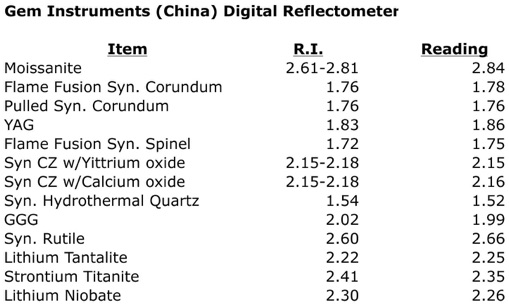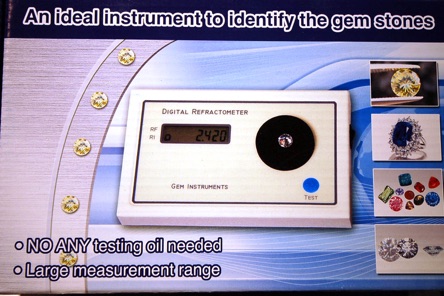A digital reflectometer from China

A confirmative tool becomes better
I’ve never been a big fan of reflectometers. Certainly the units have a place as a confirmative, as opposed to determinative, instruments, but generally they can be subject to significant error that makes the results often questionable. Also, in many cases they are sold as “the only gem instrument you’ll ever need” and their usefulness and accuracy are oftentimes much exaggerated. And of course the people that believe the claims and purchase the instruments soon become familiar with the problems inherent in their operation – or even worse, they blindly accept the results as accurate.
Certainly there are no shortcuts in determinative gemology. To accurately identify gems you need to become familiar with the many theories that characterize gemological science and you have to spend time learning to use the many instruments available and to understand how they operate and what limitations exist within the confines of their operation. All that is a lot of work, and there will always be a market for reflectometers because there are always casual gem enthusiasts looking for the “magic bullet”.
A reflectometer attempts to measure the ratio of the intensity of an infrared beam directed toward the polished surface of the gem with that of the intensity of the beam reflected back to the detector according to equations developed by Augustin-Jean Fresnel. The technique is subject to many problems, among them the quality of the surface polish, the cleanliness of the stone, the errors caused by pavilion reflection, errors from dispersion, errors induced by low battery voltage, etc.
However, the measurement of relative reflectivity in the new electronic meters can be helpful, particularly in the area of identification of diamond substitutes, most of which have indices of refraction that are over the limit of the conventional refractometer (e.g. R.I.s > 1.81).
The first of these units I’ve tested was made in China and purchased off e-Bay. Using a collection of diamond imitations from my lab I compared the actual refractive index of the material to readings from the reflectivity instrument as below:
The instrument could certainly be useful for eliminating some possibilities, but should not be used as the only source of information on which to base an identification.
Of course, in many cases it is not necessary to actually determine which diamond substitute you are dealing with as it may simply be sufficient to know that it is an imitation. In that case the meters that combine reflectivity with thermal conductivity can be valuable provided their limitations are clearly understood.


